Nature Conservation 2024 — 30. 5. 2024 — Nature and Landscape Management — Print article in pdf
European Spruce Bark Beetle Plague in the Jeseníky Mts. Protected Landscape Area – the Story (Most P
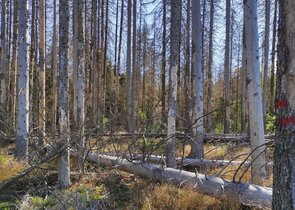
According to experts, the current European spruce bark beetle (Ips typographus) plague is unprecedentedly the greatest in the Czech Republic’s history: it avoids neither the Jeseníky Mountains Protected Landscape Area (PLA,) in northern Moravia). In the time full of changes and twists, it has generated a number of issues and questions for forest managers, nature conservationists, and the general public; it stirs emotions and it is the subject of media discussions, where opinions are often mistaken for facts. The aim of this article is to take a closer look at the course of the European spruce bark beetle outbreak in recent years in the Jeseníky Mts. PLA, primarily through specific numbers.
Causes
The current European spruce bark beetle plague is caused by synergistic effect of several drivers. First of all, these are extreme weather events, particularly droughts resulting from a lack of precipitation, especially at the beginning of the growing season, or uneven rainfall distribution throughout the year. The resulting situation was exacerbated by above-average warm weather, inter alia, accelerating the development (ontogenesis) of the European spruce bark beetle, leading to an increase in the number of its generations within the year. Both extremes were the main cause of considerable stress on the already ecologically weaker Norway spruce (Picea abies) stands, which further increased their predisposition to the attack by pathogens. Another variable is the current state of the forests – large, uniform growths of non-native spruce. It is no exception in one of the most forested PLAs in the Czech Republic, the Jeseníky Mts. PLA. The local stands – in the overwhelming majority as a result of the application of spruce even-aged forestry according to the Saxon school of net yield from the land since the end of the 18th century – are 75% made up of Norway spruce in 75%. However, according to the natural tree species composition, its proportion would not exceed 30%. Natural forest stands with a predominance of Norway spruce would be concentrated at the coldest sites – in the highest altitudes of the Jeseníky Mts. or at the bottoms of cold gorges and valleys. Today, the most preserved ones with the highest biological value are almost all part of some of the reserves. However, a large part of the Jeseníky Mts. forests is made up of artificial spruce stands established mainly in beech, fir-beech or spruce-beech habitats. It should be added that more than two-thirds of the Jeseníky Mts. PLA forests are situated in the 5th (fir-beech) to the 6th (spruce-beech) forest altitudinal zone. These are mostly spruce stands in the second to (especially) third generation. They were established with a high number of individuals per hectare, tended using inappropriate methods, they were depleted of nutrients as a result of soil acidification, etc. Such growths are literally a table set for European spruce bark beetles.
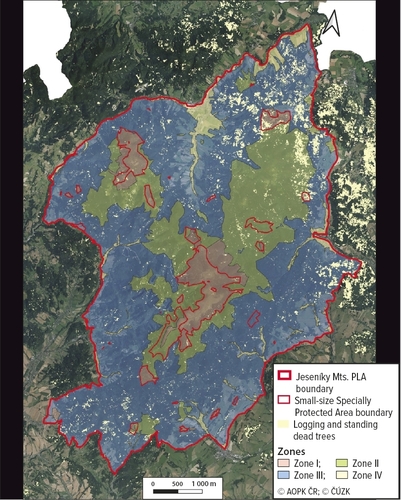
Map 1: Forests areas affected by European spruce bark beetle development on the basis of the Jeseníky Mts. Protected Landscape Area zoning (source: https://www.kurovcovamapa.cz/); 2018–2021
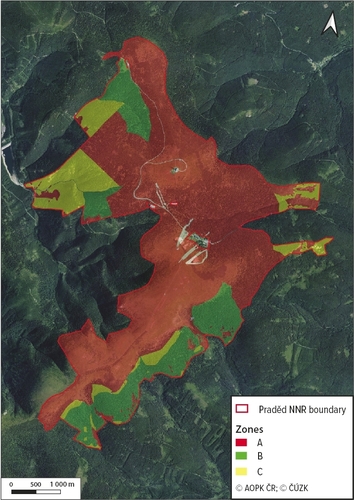
Map 2: Division of the Praděd/Great Grandfather National Nature Reserve into individual zones for the purposes of the exemption valid for 2021–2023
“European spruce bark beetle management”
In connection with the current European spruce bark beetle outbreak, the extremely dry and warm 2015 was crucial, while 2018 was not significantly different either. In 2017, when (not only) in the Jeseníky Mts. foothills, the European spruce bark beetle outbreak was already in full swing, it also moved to the edge of the PLA area. NCA CR has not yet had much practical experience with such a situation. Although the given topic resonated strongly in Šumava/Bohemian Forest Mts. National Park in the past, PLAs are a different category with different principles and approaches. In addition, greater practical experience was still missing.
From the nature conservation point of view, the limits there are given by Act No. 114/1992 Gazette on Nature Conservation and Landscape Protection, as amended later (ANCLP). In relation to remediation interventions against European spruce bark beetle: in Zones I and II outside small-size Specially Protected Areas (SSPA), the provision of Article 26 paragraph 3a) of the ANCLP prohibits the use of “intensive technologies, especially means and activities that can cause substantial changes in biological diversity, structure and function of ecosystems...”. In the case of carrying out (not only) clearance felling, it is mainly the creation of a continuous clearing with an area of more than one hectare. At that point, the State Nature Conservancy conservation authority had to make a decision on how to proceed, with two extreme options. The first was to enable the implementation of remediation measures beyond the ANCLP’’s scope, in other words, to enable the remediation of bark wood using the prohibited so-called “intensive technologies”, for which the forest administrator must have a valid exception. The second option was not to allow “intensive technologies” in the remediation of European spruce bark beetle-infested trees. In the event that such an exception was granted, it was easy to assume that, taking into account the state of most of forest stands within the area, continuous clearings exceeding one hectare would occur. One does not have to go far for proof – just look at the deforested slopes in Zlaté Hory or Bruntál regions. In contrast, by not allowing the exception there would almost certainly be an even more massive development of the European spruce bark beetle and, due to a sufficient food supply, namely adult secondary spruces on large areas, its uncontrolled spread. Not allowing clearance felling to be carried out in Zones I and II with the creation of clearings larger than one hectare, e.g. in such a way that an uncleared segment of trees would remain standing between such two areas, would mean for the forest owner or manager he an unnecessary effort on an area where they could clear without a valid permit exception. And if there were still any stands left in Zone III, they would quickly be destroyed as well.
On the basis of an agreement between the Ministry of the Environment of the Czech Republic (MoE) and the Ministry of Agriculture of the Czech Republic, forest owners applied for exemptions from the relevant provisions and clearly declared the requirement to allow the exemptions so that they could intervene against the European spruce bark beetle as effectively as possible and manage the forest sustainably. Some non-governmental organizations (NGOs) also entered individual administrative proceedings, while their positions and opinions have always differed. In the early days of the European spruce bark beetle outbreak, the request of some of them was to leave the land in Zone I and, in the first years of European spruce bark beetle development, also the land in Zone II of the Jeseníky PLA without management. Gradually, some opinions shifted and management in Zone II was no longer ruled out. In contrast, according to the opinions of other NGOs, management makes sense if certain conditions are met.
Several aspects had to be taken into account there. If effective remediation had not been implemented, even at the cost of the creation of clearings larger than one hectare, the forest stands as we know them today would probably look completely different. Establishing such large areas with limited possibilities of management against the European spruce bark beetle, moreover from forests mostly formed by long-term human activity, in Zone I and II, amounting to almost 30% of the almost 58,000 hectares of forests in the Jeseníky Mts. PLA (data does not include the forest land in the SSPA, covering just over 4,000 hectares) would mean a fundamental impact on the economic activities of e.g. private owners managing a third of the Jeseníky Mts. PLA. And no doubt it would also mean CZK tens of billions in compensation. And the difficulty would not be “only” financial. A significant aspect in the overall assessment of public interests is a social one; the employment in the forestry in the region is quite crucial. Moreover, the local forests need further management. With the dieback of the upper tree layer (canopy) over large areas, the possibility of directing forest stands to a more varied and diversified structure and species composition than most of them have today would be prevented for several decades. The forests in Zone II (and also Zone III) have been significantly altered, as a result of human activity, in favour of Norway spruce and have been intensively managed for several centuries. Thus, the forests require active long-term management. The forest restoration could also mean leaving it to spontaneous development, but in commercial forests (and PLA’s Zone II is overwhelmingly a commercial forest) there is certainly a legitimate effort for faster and targeted restoration, often with the introduction of tree species that would naturally return to the current extensive spruce forests only very slowly or not at all.
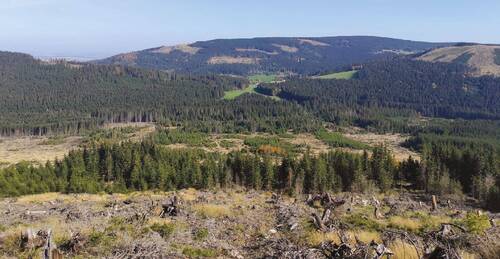
In the foreground, a mosaic of younger stands after salvage cutting (the Jeseníky Mts. Protected Landscape Are Zone II, Kobrštejn Area, Rejvíz forest on Arcibiskupské lesy a statky/ Archdiocese Forest and Farms Olomouc, Ltd. land)
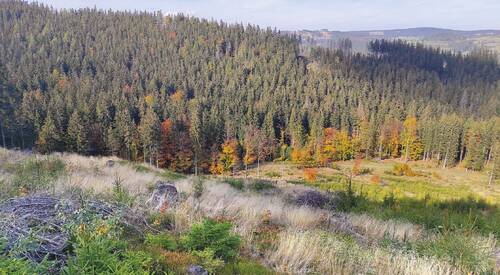
One of the first outbreak areas in the Jeseníky Protected Landscape Area Zone II with beech, birch, sycamore, and spruce; the European spruce bark beetle has almost disappeared there in the last two years (Suchý vrch/Dry Hill, BOO Vrbno pod Pradědem Forest Management Unit on land of the Ostrava-Opava Diocese)
Despite a number of objections from some NGOs, the relevant exceptions were allowed in Zone I and II of the Jeseníky Mts. PLA, and it was thus possible to process European spruce bark beetle-infested trees even with the creation of clearings larger than one hectare. In the light of what has been described, the main reason for allowing exceptions was the effort to stop the damage to stands, or at least to slow it down, or extend for the longest possible period of time with the aim of maintaining the continuity of the vegetation cover over the largest possible area. The appeals body (the MoE) also agreed with this. All of this, of course, in compliance with the conditions given by the MoE methodological recommendation “Procedure for remediation of European spruce bark beetle-infested stands in PLAs and SSPAs” (https://www.mzp.cz/cz/asanace_kurovce_doporuceni). One of the conditions of the issued decisions has been to leave at least 30 m3 of wood to decay per hectare, with the priority being all wood species on which European spruce bark beetles do not develop itself (the European silver fir Abies alba, broad-leaved deciduous trees), as well as dry Norway spruce that is no longer attractive for European spruce bark beetles, and finally cleared spruce wood. For the sake of objectivity, it should be added that, due to the fact that the European spruce bark beetle plague almost did not occur on the majority of the Jeseníky Mts. PLA (especially the western and central part), the exemptions issued were not necessary. The forest managers actually asked for them for preventive reasons.
Facts and figures
In the Jeseníky Mts. PLA, approximately 3,000 hectares of forests (around 5% of their total area) have been affected by European spruce bark beetle felling with the removal of the tree layer on a significant area (mainly with the creation of clearings) since the aforementioned year 2017. Clearings began to appear initially in Zone III in 2018 and particularly in 2019 also in Zone II. The northern, northeastern, and eastern parts of the PLA were (and remain) most affected. There, the outbreak crossed the Jeseníky Mts. PLA border from the Zlaté Hory region from the northeast and the town of Albrechtice, or the Bruntál regiom from the eastern direction, where it had already taken place several years before. To a lesser extent, it also occurred in the southern part in the vicinity of the Rabštejn Castle ruins, where the windstorm at the beginning of 2018 contributed significantly to the creation of felled areas.
Figure 1 clearly shows that the volume of spruce wood related to the European spruce bark beetle outbreak peaked in 2019, while from 2020 onwards it has been decreasing annually: between 2019 and 2020 by 19%, between 2020 and 2021 by about 36%; l in 2022 felling volumes were again lower by around 29%. For their distribution within individual zones, see Figure 2 (data does not include SSPAs) and Map 1. It is clear from the data that the European spruce bark beetle plague is primarily a matter of Zone III in the Jeseníky Mts. PLA, with its almost 63% of the forest. In addition, approximately a quarter of the total volume of harvested wood is the result of the action of one of the abiotic factors, mainly wind.
Regeneration is also an important issue directly related to remediation felling. There, it is for the forest owner to decide which trees to plant in the cleared areas. The framework is determined by the Forest Act and the relevant implementing regulations. This also includes the valid management plan for the Jeseníky Mts. PLA, reflected in the relevant forest management plans. Figure 3 shows how much the tree species composition has changed on the areas after the spruce was cleared. The European beech (Fagus sylvatica) and other trees such as the Sycamore (Acer pseudoplatanus), in the U.S. known as the Sycamore maple, birch (Betula sp.), Rowan or Mountain ash (Sorbus aucuparia), European silver fir, or European larch (Larix decidua) cover about 65% of these areas. Only around 18% of the acreage of cleared land created in 2017–2022 was afforested with Norway spruce; its natural regeneration was recorded on another 17%. As for the total extent of natural regeneration, it covers about 28% of the area.
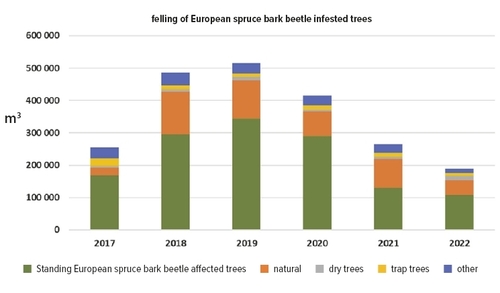
Figure 1: Volumes of wood related to felling European spruce bark beetle infested Norway spruce, including dry trees (make up about 2% of the total volumes, those were not felled) for 2017–2022 (outside small-size Specially Protected Areas); only includes data from the majority owners managing 91% of the Jeseníky Mts. Protected Landscape Area forests.
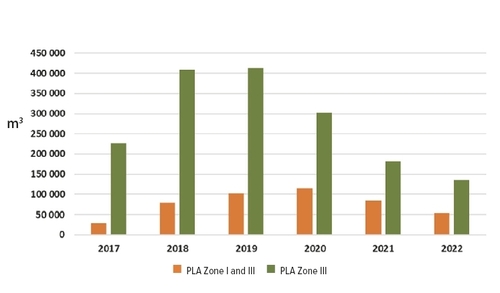
Figure 2: Total volume of European spruce bark beetle wood according to individual zones in the Jeseníky Mts. Protected Landscape Area (outside small-size Specially Protected Areas) for 2017–2022; only includes data from the majority owners managing 91% of the area of the Jeseníky Mts. Protected Landscape Area forests.
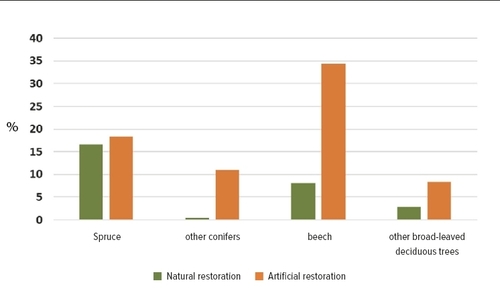
Figure 3: Species composition of the restored felled areas for 2017–2022; only includes data from the majority owners managing 91% of the Jeseníky Mts. Protected Landscape Area forests.
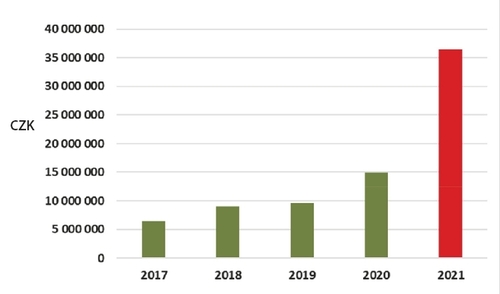
Figure 4: Summary of compensation for damage for the restriction of forest management for 2017–2021 in the Jeseníky Protected Landscape Area (assessment of applications for 2021 has not yet been fully concluded)
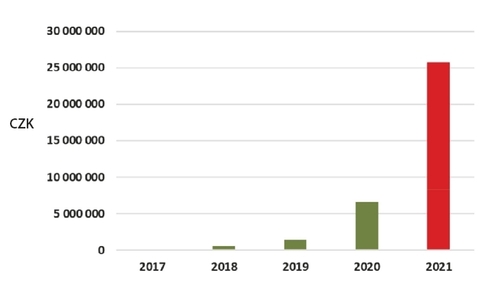
Figure 5: Summary of compensation for damage for the restriction of forest management for 2017–2021 in the Rejvíz National Nature Reserve (assessment of the request for compensation of damage in the Rejvíz NNR for 2021 has not yet been completely closed)
European spruce bark beetle in reserves
Nature reserves are part of the issue as well – areas with the strictest protection status, especially the SSPAs, where one of the subjects of protection and conservation is natural mountain or waterlogged Norway spruce forests. Coincidentally, in the case of the Jeseníky Mts. PLA, all four National Nature Reserves (NNRs) are concerned. The law there is stricter compared to Zone I or II; the provisions of Article 29 a) of the ANCLP prohibit the so-called “intensive management” leading not to “substantial change”, but to “change”, therefore any change there. The set rules in the issued exemptions primarily reflect the biological value of individual stands. For these purposes, NNRs are usually divided into three zones: zone A, with completely no intervention; zone B, with the use of nature-friendly remediation methods such as vertical debarking or debarking of trunks in their entire lengths without debranching and handling with the aim of preserving the so-called biological heritage; zone C, where a combination of nature-friendly and standard forestry practices is possible. Leaving all the wood in the stand to decay is a matter of course. As such, the European spruce bark beetle cannot threaten the natural mountain spruce trees; it is not a pest there, but a completely natural part of the mountain forest ecosystem. The problem, however, is in the condition of the stands in their vicinity, which are made up of the cultivated Norway spruces described above, usually with a proportion of spruce of 90–100%. Allowing European spruce bark beetle activity to the full extent in the reserves in this situation, however natural it may be for the forest ecosystem, would simultaneously mean a significant threat to large areas of forests adjacent to these reserves. This is one of the serious arguments in the discussion of the permitted range and the way of managing them. The European spruce bark beetle outbreak did not affect the forest reserves in the Jeseníky Mts. PLA with the same intensity as Zone II a III. The total volumes of trees damaged and undamaged by European spruce bark beetle basically fluctuate within the values from the period before 2015 or 2018, and there is only local small-scale management. The exception is the Rejvíz NNR; in addition to the Dwatf mountain pine (Pinus uncinata) growths and raised peat-bogs, it also protects waterlogged and peat-bog spruce forests. Due to the European spruce bark beetle situation of an unprecedented extent both inside and outside the reserve, almost the entire area was left without management. Management was allowed only on a small part at the southern edge in the cultivated Norway spruce sites, which are not subject of NNR protection. In this case, the situation is also complicated in terms of ownership – the entire reserve is surrounded by the property of the Archdiocese of Olomouc, while the NNR remained under the management of Forests of the Czech Republic, State Enterprise.
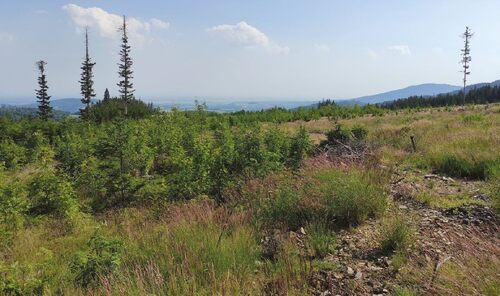
Natural restoration of rowan and spruce in the outbreak area (the Jeseníky Protected Landscape Area Zone III, Zámecký pahorek/Castle Hillock site, Rejvíz forest on Arcibiskupské lesy a statky/ Archdiocese Forest and Farms Olomouc, Ltd. land)
Money for nature
The whole European spruce bark beetle episode also has an impact on the finances directed to nature conservation. Basically, two financial instruments are used. The first is compensation for damage pursuant to the ANCLP – it is based on the principle that anyone who suffers damage as a result of a restriction resulting from a decision (binding opinion or consent) issued pursuant to the ANCLP is entitled to financial compensation if certain conditions are met. Therefore, we must always carefully consider every expenditure of public funds. We must think about whether the funds are spent effectively and whether they could be used elsewhere generating greater benefit. Although the decision making itself is not directly influenced by the possible amount of compensation, its economic and social impacts must also be considered. In the case of the Jeseníky Mts. PLA, it is mainly about compensation for damage for extraordinary and more cost-intensive measures, particularly as nature-friendly remediation methods and wood left in the stands to decay. The balance of damages paid out in the Jeseníky Mts. PLA, or the increase between 2018 and 2021 is shown in Figure 4. While compensation for damage amounted to less than CZK 6.5 million (EUR 260,000) in 2017, it more than doubled in 2020 and almost sixfold in 2021 compared to 2017. With regard to the amendment to Decree No. 335/2006 Gazette stipulating the conditions and method of providing financial compensation, the amount of this compensation for 2022 will be significantly higher. Figure 5 then shows how significantly the financial compensation applied for restrictions in the Rejvíz NNR changes the entire balance.
The second important financial source for nature conservation in forest ecosystems are funds from the State Budget from the Landscape Management Programme and funds from the Operational Programme Environment, the latter being financed by the European Union. There, the Nature Conservation Agency of the Czech Republic (NCA CR) invests around CZK 3.5 million (EUR 140,000) every year in planting, underplanting, protection against wild animals, and in nature-friendly remediation methods. For example, for the period 2017–2022, it was just over CZK 20 million (EUR 790,000) in total.
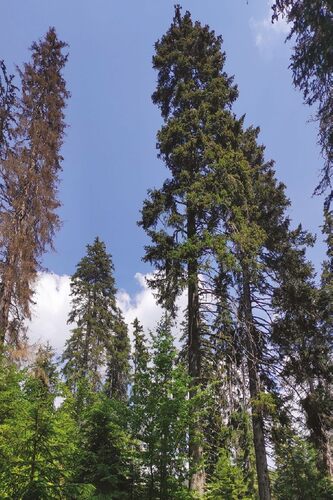
Primary forest-like spruce growth in the Praděd/Great Grandfather National Nature Reserve; the European spruce bark beetle is not a pest there
Conclusion
Despite the fact that the trends of the last three years indicate a decrease in salvage cutting and thus a certain attenuation of European spruce bark beetle development, the entire outbreak cannot be considered finished. A persistent risk has been possessing by large areas of secondary spruce forests, which are influenced by the weakening of previous years. Despite this, at some sites the European spruce bark beetle has practically stopped and only a few dozen trees were cut. Remediation management (undoubtedly also with the help of the weather), or permitted exemptions, the main purpose of which is to slow down the secondary spruce stand dieback, had the desired effect. The impact of the above measures in forests effected by the European spruce bark beetles, particularly the removal of the tree layer/canopy on a significant area of about 5% of the Jeseníky Mts. PLA forests and, at the same time, the ongoing decline in extraction of European spruce bark beetle effected trees speaks for itself.
The consequences of extraction of European spruce bark beetle effected trees on forest ecosystems can be discussed from a number of perspectives. However, based on the data on the subsequent restoration of the areas, we can say with some simplification that the situation in the areas is better than it was before the actual extraction, even in terms of the tree species composition. In addition, compared to the previous stands, a different fine mosaic of habitat patches was often created in terms of age or space. In a way, the dieback of ecologically weak Norway spruce trees can be seen as an opportunity for the return of new forests with more varied species and spatially more diverse, i.e. significantly different from the ones we have been used to until now. From this point of view, it is much more important what the further approach of forest managers will be to these areas than the fact that there has been the creation of cleared areas without mature forest. The development of newly emerging stands will depend mainly on the way they are tended; the widest possible range of tree species that naturally belong to the given habitat should be preferred and supported.
With the exception of the Rejvíz NNR, the European spruce bark beetle state of play in the SSPAs shows a normal state and does not deviate in any fundamental way from the “normal” before 2015. There are generally partial management measures in an attempt to preserve as much as possible the biological heritage and the attributes associated with it, which is important for forest ecosystem restoration or as a refuge for the biota it hosts. However, the European spruce bark beetle does not know the boundaries of the reserve, and the problem is, above all, the highly unsatisfactory state of the surrounding stands in terms of the species composition.
For the time being, the chosen method has prevented the rapid dieback of cultivated spruce forests on large areas, albeit locally at the cost of deforested areas and the creation of clearings. Also, the possibility to carry out partial interventions on a small scale in the reserves did not lead to further European spruce bark beetle development beyond the reserves’ borders. In the context of the stated facts, the authors consider the decisions taken and the procedures applied to be rational and, in the current situation, the best possible solution.
Despite the (slightly) optimistic development of the whole situation in recent years, it must be emphasized that nature itself will have the key word in the future, and the weather will be the decisive factor in the coming years, mainly the rainfall volume and temperature dynamics. The story of the European spruce bark beetle outbreak in the Jeseníky Mts. PLA (most probably) continues...
The Nature Conservation Agency of the Czech Republic hereby thanks the individual forest owners for providing data, namely Forests of the Czech Republic, Biskupské lesy/Diocese of Ostrava-Opava Forests, and the Arcibiskupské lesy a statky/ Archdiocese Forest and Farms Olomouc, Ltd. ■
- - - -
Cover photo:
The Rejvíz National Nature Reserve – area left without European spruce bark beetle management

